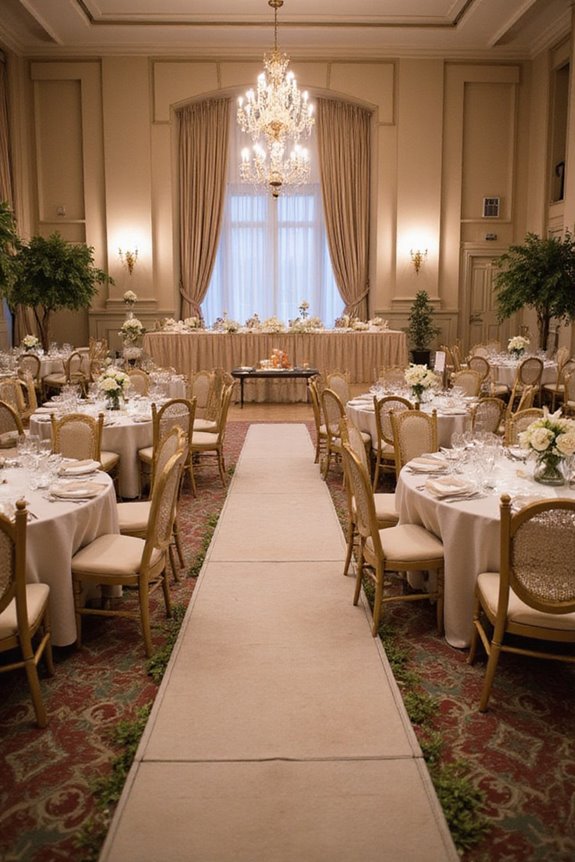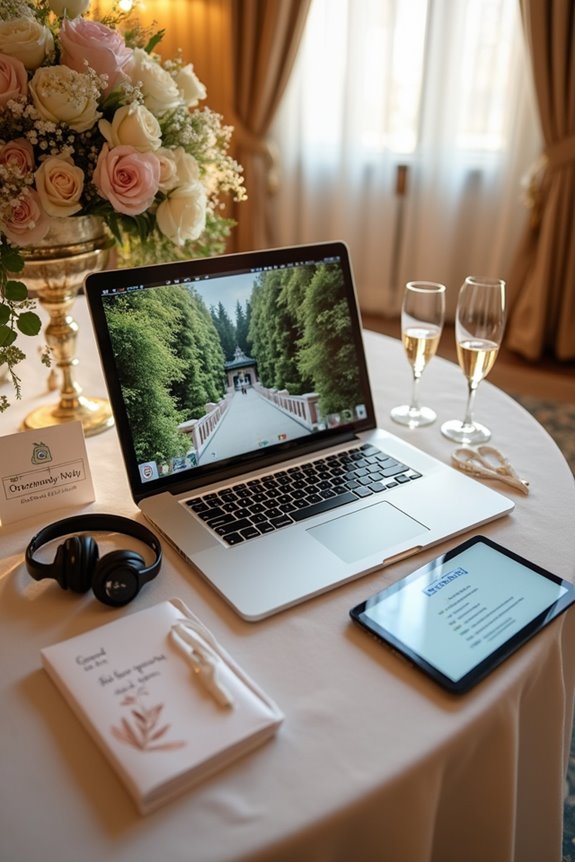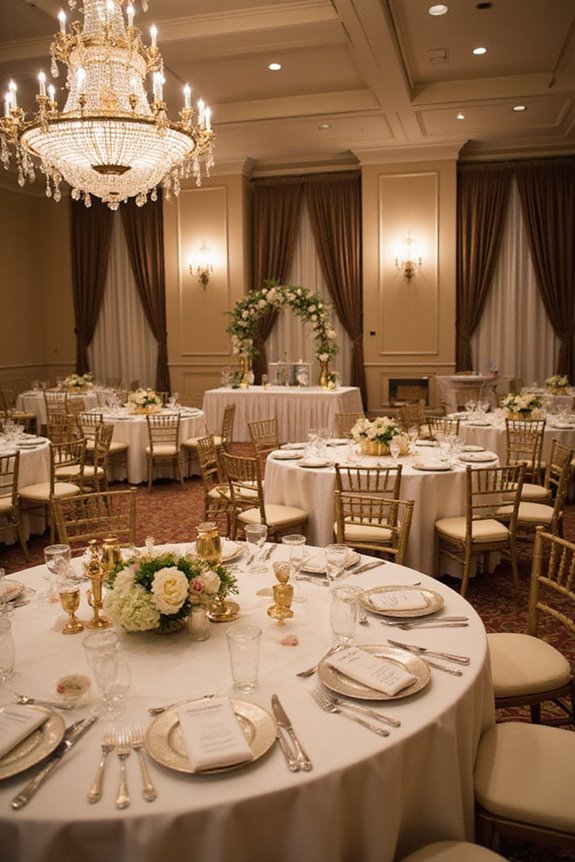To guarantee accessibility at our event, we should start with clear policies and a simple request form for attendees. Choosing a venue with barrier-free entrances and ADA-compliant restrooms is a must. We can enhance communication by offering sign language interpreters and live captions. If we’re hosting virtually, let’s pick platforms that support accessibility features. Plus, gathering feedback helps us improve for next time. Let’s explore more effective strategies together!
Key Takeaways
- Establish clear accessibility policies and document procedures for accommodation requests early in the planning process.
- Ensure the venue is barrier-free with accessible parking, pathways, and seating arrangements for wheelchair users.
- Include accessibility statements in promotional materials and gather attendees’ communication needs during registration.
- Implement virtual event platforms that adhere to WCAG standards and provide features like real-time captioning.
- Collect feedback on accessibility features post-event to assess effectiveness and make continuous improvements.
Pre-Event Planning and Policy Compliance
When we start planning an event, it’s easy to overlook important details, especially when it comes to accessibility. To avoid this, let’s establish clear accessibility policies early on. Documenting accommodation procedures is key. For instance, create a simple form for attendees to request specific needs, like sign language interpreters or accessible seating.
We should also guarantee our promotional materials highlight these features. Imagine a guest wondering if they can access the stage or find a quiet space. Clear communication can make all the difference! Plus, let’s train our staff on how to handle requests. By preparing in advance, we not only comply with ADA standards but also create an inclusive environment where everyone feels welcome.
Venue Accessibility and Physical Considerations

Ensuring our venue is accessible for everyone isn’t just a nice-to-have; it’s vital for creating an inclusive atmosphere.
Venue Layout
Let’s start with the entrance. Make sure it’s barrier-free, with ramps and clear pathways leading to registration and event spaces. Aisles should be at least 36 inches wide, and ideally, we want 64 inches for two-way traffic.
Accessibility Features
Accessible parking spots should be close to the entrance. Clear signage is important for guiding attendees. Inside, seating arrangements should allow space for wheelchair users, and restrooms must comply with ADA specifications.
Communication and Inclusive Access

While it might seem challenging, making communication accessible at events is something we can all tackle together. First, let’s include clear accessibility statements in our promotional materials. This way, attendees can easily communicate their access requests. We should also ask attendees about their communication needs when they register.
During the event, it’s essential to announce available accessibility services upfront. Offering live captions and sign language interpreters can make a big difference. Let’s keep our language simple, avoiding jargon that might confuse.
Finally, let’s provide various ways for attendees to engage, whether through chat or verbal participation. By being proactive, we can create an inclusive environment where everyone feels comfortable and connected. Together, we can make communication accessible!
Virtual Event Accessibility

Virtual events can be a fantastic way to connect, especially if we keep accessibility in mind. First, let’s focus on virtual platform selection. We should pick platforms that meet Web Content Accessibility Guidelines (WCAG). Features like real-time captioning and strong screen reader support are vital.
Next, we can offer clear instructions on using accessibility technology. Think step-by-step guides or videos to help attendees enable closed captions and keyboard shortcuts.
Lastly, testing is important! We need to make sure everything works with assistive devices and that captions are accurate. Don’t forget to assign someone to help attendees during the event! If we keep these tips in mind, our virtual event can truly be inclusive for everyone.
Legal and Ethical Considerations

When planning events, it’s essential to remember that legal and ethical considerations go hand in hand. We must adhere to the Americans with Disabilities Act (ADA) to protect disability rights. This means ensuring our venues have accessible entryways, restrooms, and seating.
Problem: Many venues overlook these needs.
Solution: Before signing a contract, verify accessibility features like ramps and clear signage.
Beyond compliance, ethical inclusion means prioritizing everyone’s experience. We can provide sign language interpreters and accessible materials, ensuring no one feels left out.
Problem: Attendees might hesitate to ask for accommodations.
Solution: Offer options upfront and create a welcoming atmosphere.
Measurement and Continuous Improvement
Creating an inclusive environment doesn’t stop at legal compliance; we also need to measure how well we’re doing and find ways to improve. To start, we should track accessibility metrics like attendance rates of individuals with disabilities compared to overall participation. This helps us see where we stand.
Next, let’s collect attendee feedback through surveys focusing on accessibility features and accommodations. Analyzing this feedback allows us to identify gaps and prioritize improvements.
We can also monitor the usage of services like sign language interpreters or captioning. By conducting post-event audits, we assess how effective our accommodations were. Remember, continuous improvement is key. Engaging with disability advocacy groups can provide expert insights, reminding us that we’re all on this journey together!
Designating Accessibility Coordinators
Designating accessibility coordinators is a key step in making our events truly inclusive. These individuals should have strong coordinator qualifications, including knowledge of accessibility laws like the ADA. Their coordination responsibilities involve developing and monitoring policies to eliminate barriers. For example, they can conduct venue audits to identify issues and guarantee compliance with regulations.
It’s essential they engage with attendees who have disabilities, gathering feedback to improve our events continually. Coordinators also manage accommodations, like providing assistive technology and alternative formats. By collaborating with event planners and staff, they help create an environment where everyone feels welcome. Ultimately, having dedicated coordinators helps us create events that are not just accessible but enjoyable for all.
Training Staff on Accessibility Practices
Training our staff on accessibility practices is essential for creating an inclusive environment at events. We can achieve this through staff workshops focused on disability etiquette and respectful communication. For instance, we’ll teach everyone to ask before assisting someone with a mobility aid.
Incorporating role-playing exercises can help staff practice real-life scenarios, boosting their confidence in providing support. Familiarizing them with assistive technologies, like hearing devices, guarantees they can troubleshoot issues on the spot.
Communication is key, so we’ll emphasize using accessible formats for all event materials. Finally, let’s encourage open discussions about challenges and solutions, creating a supportive atmosphere where everyone feels valued. It’s about making certain no one gets left behind, right?
Engaging With Disability Advocacy Groups
When we think about making our events truly accessible, engaging with disability advocacy groups can be a game changer. By forming advocacy partnerships, we can tap into their expertise and insights. For instance, reaching out to groups like the American Association of People with Disabilities can guide our accessibility strategies. They can help us understand universal design principles and identify potential barriers.
Involving these groups early in our planning guarantees we integrate accessibility from the start. We can even organize pre-event walkthroughs with them! Plus, they can assist us in training staff and promoting our event through their networks. With their help, we not only create a welcoming environment but also show our commitment to inclusivity. Let’s make it happen!
Frequently Asked Questions
What Are Some Common Accessibility Challenges Faced by Event Attendees?
We’ve all felt trapped in a maze; attendees often face physical barriers, like inaccessible venues, and sensory impairments that complicate their experience. These challenges highlight the need for thoughtful design and consideration in event planning.
How Can I Promote My Event to Reach Individuals With Disabilities?
To effectively promote our event, we should focus on targeted outreach and inclusive marketing. By using authentic representation and engaging with the disability community, we can enhance our message and guarantee broader participation.
What Resources Are Available for Creating Accessible Event Materials?
When we think of accessible technology, it’s like building a bridge. By embracing inclusive design, we can create event materials that everyone can enjoy—think accessible PDFs, audio descriptions, and user-friendly formats that truly welcome all.
How Do I Handle Last-Minute Accommodation Requests From Attendees?
When handling last-minute requests, we prioritize clear attendee communication. We quickly assess needs, collaborate with our team, and guarantee prompt responses, demonstrating our commitment to inclusivity and flexibility in accommodating every attendee effectively.
What Are the Costs Associated With Implementing Accessibility Features at Events?
When we think about costs associated with accessibility, we should include budget considerations like hiring interpreters and providing assistive devices. A detailed cost breakdown helps us allocate funds effectively and guarantee all attendees feel welcome.





